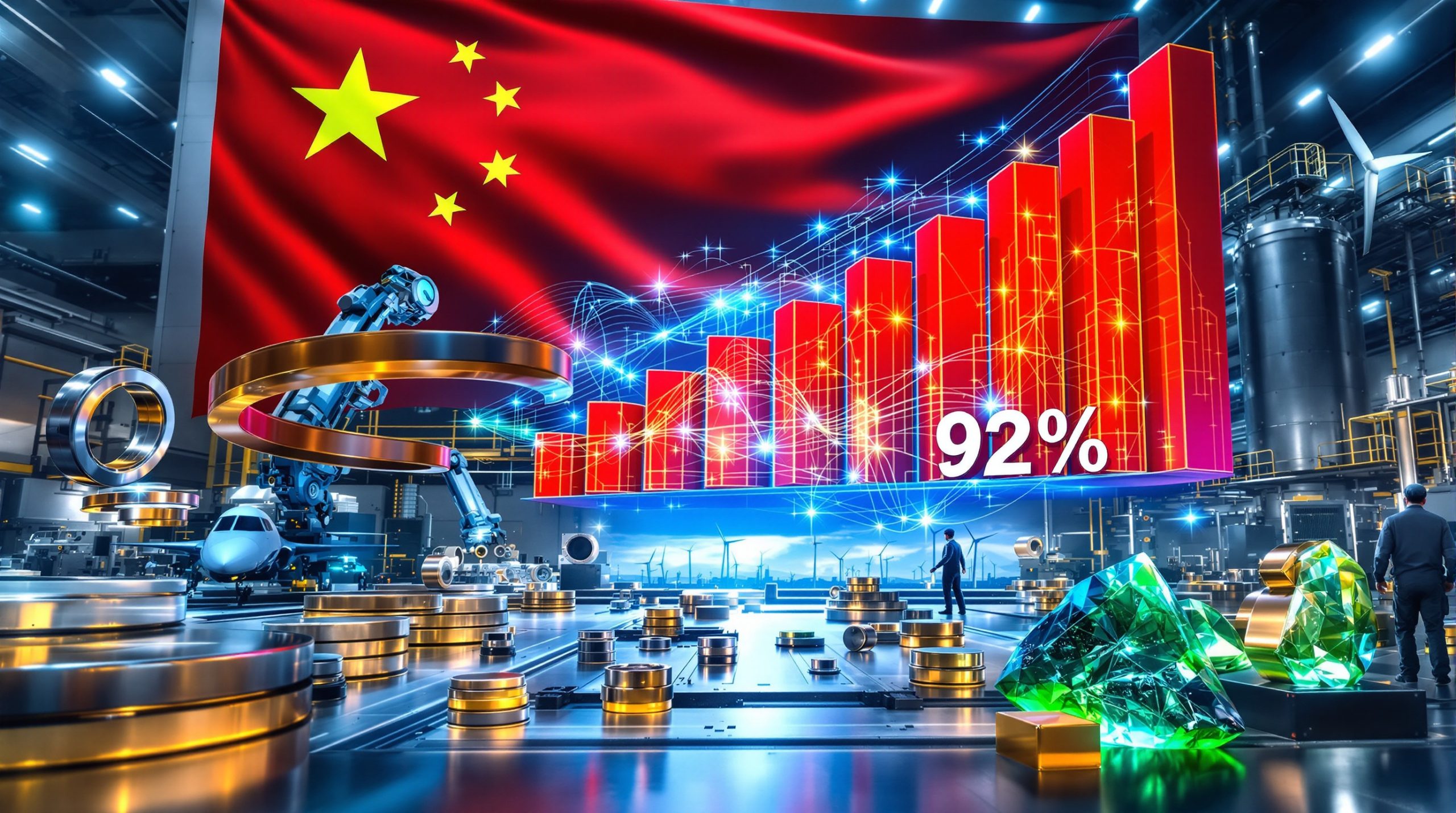The Strategic Importance of Tungsten in Global Security and Industrial Applications
Tungsten, a remarkable metal often overlooked in discussions of critical materials, represents one of the most strategically significant elements in modern industry and defense. With unique physical properties that make it irreplaceable in numerous applications, tungsten has become the focus of growing geopolitical concern as supply chains face unprecedented scrutiny. The metal's exceptional hardness, unmatched density, and extraordinary heat resistance position it at the intersection of industrial necessity and national security priorities.
As global tensions rise and nations reassess their strategic vulnerabilities, tungsten supply has emerged as a critical concern, particularly given China's domination of approximately 90% of global production. This concentration creates significant risks for Western manufacturing and defense capabilities, highlighting the strategic importance of developing alternative supply sources like Almonty Industries and tungsten production in South Korea.
What Makes Tungsten an Irreplaceable Strategic Metal?
Unique Physical Properties That Drive Industrial Demand
Tungsten possesses a combination of physical properties that make it virtually irreplaceable in many critical applications. With the highest melting point of any metal at 3,422°C, exceptional density of 19.25 g/cm³ (nearly matching gold), and extraordinary hardness (7.5 on the Mohs scale), tungsten stands alone among industrial metals in its performance under extreme conditions.
These remarkable properties enable tungsten to function where other metals would immediately fail. The metal retains its structural integrity at temperatures that would melt most other materials, making it indispensable in high-temperature industrial processes. Its exceptional density provides unmatched performance in applications requiring weight in minimal space, while its hardness contributes to wear resistance that extends the lifespan of crucial components.
The industrial applications leveraging these properties include:
- Tungsten carbide cutting tools that maintain their edge during high-speed machining
- High-temperature furnace components that can withstand extreme heat in manufacturing
- Radiation shielding in medical facilities and nuclear installations
- Electrical contacts in high-performance electronics and power distribution systems
- Heat sinks in advanced computing systems that prevent thermal damage
What many don't realize is that tungsten's combination of properties remains unmatched by any synthetic alternative despite decades of materials science advancement. This irreplaceability explains why governments increasingly classify tungsten as a truly strategic material amid growing critical mineral shortages.
The Dual-Use Nature: From Smartphones to Defense Systems
Tungsten exemplifies what security experts classify as a "dual-use" material—one with both civilian and military applications that are often indistinguishable in supply chains. This dual-use nature creates complex challenges for trade policy and strategic planning.
In civilian applications, tungsten plays critical yet often invisible roles:
- The vibration mechanism in every smartphone contains tungsten counterweights
- LED lighting relies on tungsten heat dissipation components
- Automotive safety systems use tungsten alloys in crash absorption structures
- Aerospace components require tungsten's heat resistance in jet engines
- Medical imaging devices utilize tungsten for radiation collimation
The military applications, however, highlight tungsten's truly strategic importance:
- Kinetic energy penetrators used in anti-tank munitions depend on tungsten's density
- Hypersonic missile components must withstand extreme temperatures that only tungsten can handle
- Microwave weapons systems use tungsten waveguides for directed energy
- Advanced aircraft use tungsten counterweights for precise balance and control
- Armor plating incorporates tungsten alloys to defeat sophisticated penetrators
This dual-use status creates a particular challenge: civilian supply chains can inadvertently mask defense procurement, making it difficult to distinguish between commercial and military demand. As trade tensions rise between China and Western nations, this blurred line between civilian and military tungsten applications has significant implications for export controls and trade policies.
How Has China Dominated the Global Tungsten Supply Chain?
The 90% Control Problem and Its Implications
China's dominance in global tungsten production represents one of the most concentrated commodity supply chains in the world. Current estimates place Chinese control at approximately 90% of global tungsten production—a level of concentration that creates profound vulnerabilities for industrial nations dependent on this critical metal.
This near-monopoly didn't happen by accident. China's dominance stems from a combination of factors:
- Abundant geological reserves, particularly in Jiangxi and Hunan provinces
- Decades of strategic investment in mining and processing infrastructure
- Lower environmental compliance costs that reduced production expenses
- Integrated supply chains from mining through processing to manufacturing
- Government policies that prioritized mineral resource development
The implications of this concentration extend far beyond simple market dynamics. When one nation controls 90% of a critical resource, it gains significant leverage in both economic and geopolitical spheres. For Western manufacturers, this creates vulnerabilities including:
- Supply interruptions during periods of political tension
- Price volatility driven by Chinese export quotas rather than market forces
- Quality inconsistencies that can affect performance in critical applications
- Reduced innovation as supply constraints limit experimentation with new applications
- Strategic vulnerability in defense supply chains dependent on Chinese materials
Perhaps most concerning is how this concentration intersects with growing geopolitical tensions. Unlike oil or other commodities with diverse global suppliers, tungsten's concentrated supply chain offers few immediate alternatives if Chinese exports face disruption, requiring careful consideration of geopolitical investor strategies.
Recent Export Restrictions and Their Global Impact
In recent years, China has implemented increasingly stringent controls on tungsten exports, citing environmental concerns and domestic resource needs. These restrictions have triggered significant ripple effects throughout global manufacturing supply chains and raised alarm among defense planners.
The most recent export controls include:
- Reduced export quotas for tungsten concentrate by approximately 20%
- New licensing requirements for tungsten powder exports
- Enhanced scrutiny of end-users, particularly those with defense connections
- Restrictions on technology transfer for processing methods
- Environmental compliance requirements that favor domestic processors
These export restrictions appear to be part of a broader response to Western technology controls, particularly those targeting semiconductor manufacturing equipment and advanced computing. The timing suggests a strategic use of mineral resource leverage as a counterbalance to Western technology restrictions, similar to patterns seen with Trump's commodity policies.
The market impacts have been substantial, including:
- Price increases of 30-40% for certain tungsten products over 24 months
- Supply delays affecting precision tooling manufacturers in Europe and the U.S.
- Stockpiling behavior among major industrial users anticipating further restrictions
- Accelerated exploration and development of non-Chinese tungsten resources
- Increased attention from defense procurement agencies seeking secure supply chains
Perhaps most significant is the psychological impact on manufacturers who previously took stable tungsten supplies for granted. The recognition of supply chain vulnerability has triggered a fundamental reassessment of sourcing strategies and risk management across industries dependent on tungsten and other critical minerals.
What Is Almonty Industries' Role in Reshaping Tungsten Supply?
The Strategic Significance of the Sangdong Project
Almonty Industries and tungsten production in South Korea represents the most significant non-Chinese tungsten development project in decades. Set to begin production within the next two months, this historic mine revival marks a potential turning point in global tungsten supply dynamics.
The Sangdong project stands out for several reasons:
- It contains one of the world's largest tungsten deposits outside China
- The mine benefits from existing infrastructure from its previous operational period
- South Korea provides a stable political environment with strong rule of law
- Proximity to major industrial centers in Korea and Japan reduces logistics complexity
- Modern processing technology promises competitive production costs despite higher labor expenses
Historically, the Sangdong mine was once among the world's largest tungsten producers before closing in the 1990s due to low tungsten prices driven by Chinese exports. Its revival represents not just a commercial mining project but a strategic realignment of tungsten supply chains away from Chinese dependence.
The mine's location in South Korea carries particular strategic significance. As a key U.S. ally with strong industrial infrastructure and advanced manufacturing capabilities, South Korea offers an ideal environment for developing an alternative tungsten supply chain. The country's own high-tech industries provide a ready market for locally produced tungsten, creating a natural economic ecosystem that supports the project's viability.
With production capacity projected at approximately 3,500 metric tons annually when fully operational, the Sangdong mine won't immediately displace Chinese dominance, but it establishes a critical alternative supply source in a geopolitically stable region.
From Canadian to American: The Strategic Redomiciliation
In a move that underscores the geopolitical dimensions of tungsten supply, Almonty Industries recently completed its redomiciliation from Canada to the United States. This corporate restructuring transforms the company from Canada's largest tungsten producer to America's largest tungsten producer, despite not having production facilities in either country.
This relocation from Toronto to Delaware reflects more than a simple corporate address change—it represents strategic positioning within the emerging landscape of critical mineral security. By establishing itself as an American corporation, Almonty gains several strategic advantages:
- Alignment with U.S. defense industrial base priorities
- Potential access to Defense Production Act funding for critical minerals
- Enhanced eligibility for defense procurement programs requiring domestic suppliers
- Reduced regulatory complications for supplying sensitive defense applications
- Strategic positioning for partnerships with U.S. defense contractors
What makes this move particularly noteworthy is its timing amid growing U.S. government concern about critical mineral supply chains. The redomiciliation coincides with increased Department of Defense focus on supply chain security and the implementation of new policies prioritizing domestic and allied sources for strategic materials.
For investors considering investing in mining stocks, this corporate restructuring signals Almonty's strategic focus on the defense and high-tech sectors rather than just commercial markets. It positions the company to potentially command premium pricing for "secure" tungsten sources rather than competing purely on cost with Chinese producers.
How Does Tungsten Fit Into Modern Defense Strategy?
The Critical Role in Weapons Systems and Military Hardware
Tungsten's unique properties make it indispensable in advanced weapons systems and military hardware, where performance requirements are exceptionally demanding. Modern defense applications leverage tungsten's density, hardness, and heat resistance in ways that have no ready substitutes.
Among the most critical military applications are:
-
Kinetic Energy Penetrators: Tungsten's exceptional density (19.25 g/cm³) makes it ideal for armor-piercing munitions. These dense, hardened projectiles can penetrate reinforced armor through sheer kinetic force, without requiring explosive charges. The 120mm sabot rounds used in main battle tanks rely on tungsten penetrators to defeat enemy armor.
-
Armor Plating: In a defensive application, tungsten-based composites provide exceptional protection against incoming projectiles. When layered with other materials in advanced armor systems, tungsten helps dissipate and absorb the energy of incoming rounds.
-
Missile Components: Hypersonic missiles, operating at speeds above Mach 5, generate extreme temperatures through air friction. Tungsten's melting point of 3,422°C makes it one of the few materials capable of maintaining structural integrity in these conditions, particularly in nose cones and control surfaces.
-
Guidance Systems: Precision guidance systems rely on tungsten components for both weight and heat resistance. Inertial guidance systems use tungsten counterweights, while the electronics must be protected from the heat generated during high-speed flight.
-
Electronic Warfare: Modern electronic warfare systems generate significant heat during operation. Tungsten heat sinks and thermal management components maintain operational temperatures for sensitive electronics.
The growing importance of these applications helps explain why defense planners have recently elevated tungsten on their critical minerals lists. As weapons systems become more sophisticated, the demand for tungsten's unique properties increases proportionally, creating potential supply vulnerabilities if access to tungsten becomes constrained.
Strategic Reserves: The Forgotten Priority
The concept of strategic mineral reserves underwent significant changes after the Cold War, with many Western nations substantially reducing their stockpiles under the assumption that global markets would ensure availability. This approach has proven increasingly problematic as supply chains concentrate and geopolitical tensions rise.
During the Cold War, the U.S. maintained the National Defense Stockpile with substantial reserves of tungsten and other strategic minerals. However, post-Cold War optimism led to significant drawdowns:
- The U.S. strategic tungsten reserve declined from approximately 50,000 tons in 1988 to less than 7,500 tons by 2010
- European nations similarly reduced strategic stockpiles, often eliminating them entirely
- Just-in-time inventory practices replaced strategic reserves throughout Western industry
- Commercial dependency on Chinese supply increased as Western mines closed
This reduction in strategic reserves occurred precisely as China consolidated its dominance of tungsten production, creating a strategic vulnerability that has only recently received renewed attention. The contrast with Chinese policy is striking—while Western reserves declined, China established a State Reserve Bureau that systematically acquired strategic minerals including tungsten.
Current efforts to reestablish strategic reserves face significant challenges:
- Limited non-Chinese production capacity constrains rapid stockpile building
- Price sensitivity creates budgetary challenges for large-scale acquisitions
- Technical expertise in tungsten metallurgy has diminished in Western nations
- Storage and management infrastructure for strategic reserves requires rebuilding
The renewed focus on tungsten as a strategic mineral highlights a broader reassessment of critical mineral security policies in Western nations. Defense planners increasingly recognize that market mechanisms alone may not ensure access to critical materials during periods of geopolitical tension.
What Are the Investment Implications of Tungsten Supply Chain Restructuring?
Defense Spending Growth vs. Traditional Tungsten Market Projections
A significant disconnect exists between traditional tungsten market projections and current defense spending trends, creating potential investment opportunities. Historical tungsten demand growth estimates typically ranged from 1-2% annually, reflecting incremental changes in industrial applications. However, current defense spending is growing at 9.4% per year, with tungsten-intensive applications growing even faster.
This divergence creates several important market dynamics:
- Traditional market analyses likely underestimate forward tungsten demand
- Price projections based on historical patterns may significantly undervalue future supply
- The premium for secure, non-Chinese tungsten sources may expand significantly
- Defense procurement could become a larger and more stable market segment
- Price volatility may increase as structural supply shortages develop
For investors seeking global commodities insights, this divergence represents a potential market inefficiency—current tungsten prices don't fully reflect the emerging defense-driven demand profile. Historical commodity analysis typically focuses on broader industrial demand rather than strategic demand, potentially missing the impact of defense budgets on specific critical minerals.
The defense spending growth reflects broader geopolitical tensions and the modernization of weapons systems across NATO countries, China, and other major powers. These next-generation systems often require more tungsten per unit than their predecessors due to increased performance requirements and sophisticated components.
The First-Mover Advantage in Western Tungsten Production
Almonty Industries and tungsten production in South Korea provides significant competitive advantages as a first mover in re-establishing Western tungsten production capacity. While numerous exploration companies have identified tungsten resources, few have advanced to production readiness, and even fewer have secured the financing necessary to begin operations.
This first-mover advantage includes several dimensions:
- Established relationships with major industrial and defense customers
- Technical expertise in tungsten mining and processing, which has become scarce
- Regulatory approval pathways already navigated in multiple jurisdictions
- Financing secured during challenging market conditions before wider recognition of tungsten's strategic importance
- Brand recognition and credibility with both customers and investors
The company's additional tungsten assets in Spain provide further growth potential and geographical diversification. The Los Santos mine in western Spain represents an additional production source in NATO territory, while the Valtreixal project offers future expansion potential as demand for non-Chinese tungsten increases.
For investors, the first-mover advantage translates to reduced development risk compared to earlier-stage projects. With permitting, financing, and construction hurdles already addressed, the focus shifts to execution and production ramp-up rather than the more speculative aspects of resource development.
How Are Global Supply Chains Being Restructured Around Critical Minerals?
The Shift from Offshoring to Onshoring and Friend-Shoring
A fundamental restructuring of global supply chains is underway, with critical minerals like tungsten at the center of this transformation. After decades of prioritizing cost efficiency through offshoring to lowest-cost producers, companies and governments are now emphasizing security and reliability through onshoring and friend-shoring initiatives.
This restructuring encompasses several key trends:
- Onshoring: Bringing production capacity back to domestic locations despite higher costs
- Friend-shoring: Establishing supply relationships with politically aligned nations
- Supply chain mapping: Identifying vulnerabilities and critical dependencies through detailed analysis
- Diversification: Reducing concentration risk through multiple suppliers, even at cost premiums
- Vertical integration: Controlling multiple supply chain stages to ensure security
This shift represents more than just a pendulum swing in business strategy—it reflects a fundamental reassessment of risk in an era of increasing geopolitical tension. Companies increasingly view supply chain disruption as a greater risk than incrementally higher production costs, particularly for critical components and materials.
For tungsten specifically, this restructuring manifests in several ways:
- Willingness to pay premium prices for non-Chinese sources
- Investment in processing facilities outside China to handle concentrates
- Long-term contracts with Western-aligned suppliers to support financial viability
- Development of recycling capabilities to reduce primary material dependency
- Technical research into material efficiency to reduce overall tungsten requirements
This restructuring creates opportunities for companies like Almonty that are positioned to provide secure supply from politically stable jurisdictions. The premium that customers are
Ready to Invest in the Next Major Mineral Discovery?
Discovery Alert instantly notifies investors of significant ASX mineral discoveries using its proprietary Discovery IQ model, transforming complex mineral data into actionable insights. Understand why historic discoveries can generate substantial returns by visiting Discovery Alert's dedicated discoveries page and begin your 30-day free trial today to position yourself ahead of the market.




